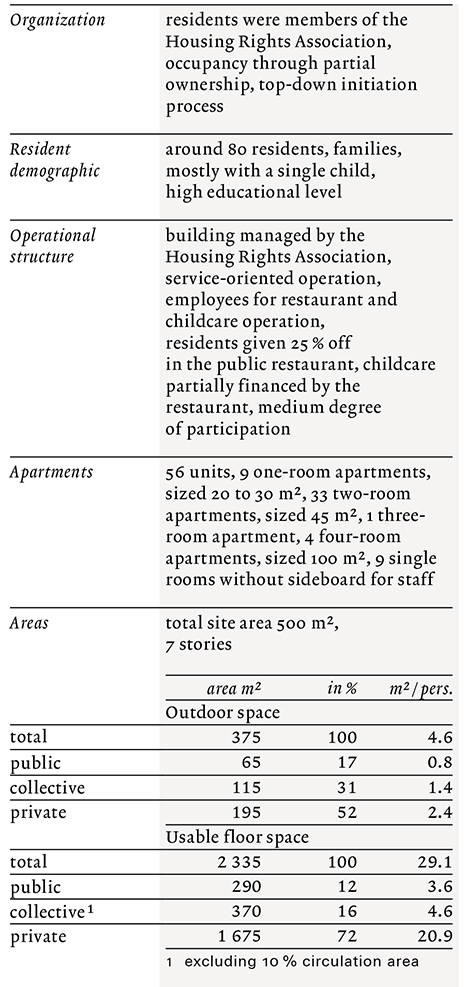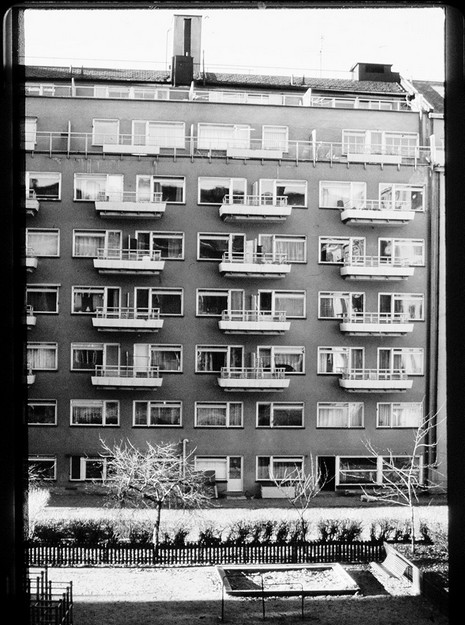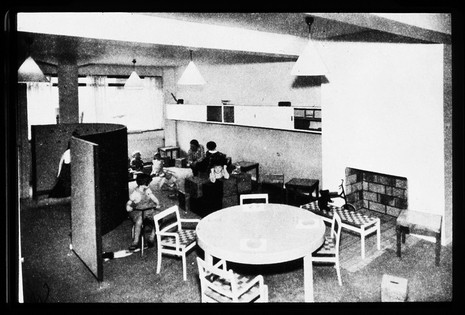Description
The most well-known Central- Kitchen House is the John Ericsonsgatan Collective House in Stockholm, which was initiated in 1935 by architect and later municipal master builder Sven Markelius and sociologist Alva Myrdal. Although the term “collective house” could also refer to a different category of collective living, this project is clearly modelled on the Central-Kitchen House. Instead of private kitchens, the 50 one- to four-room apartments had a small cupboard kitchen connected by a dumbwaiter with the central kitchen.[1] Unlike with previous Central-Kitchen Houses, this project clearly emphasized shared areas and collective childcare. Relieving the dual burden on Swedish women and professionalizing housework and other family tasks was not only important for Myrdal; the Swedish state also advocated all-day childcare and promoted collective residences, in response to a significant decline in births during the 1930s.[2] For example, a government loan for housing stimulation provided financial support for the John Ericsonsgatan Collective House.
Alva Myrdal saw a considerable waste of time and energy in amateurly fulfilled housework tasks and wanted to strengthen families by collectivizing household care and child-rearing, maintaining that reducing the double burden on women would help increase intimacy and closeness within families.[3] For this reason, a range of separate living spaces such as a nursery and a public restaurant were included. Individual families could decide whether they wanted to eat in the restaurant or in their own apartment dining room, and children could be delivered to the daycare facility on an individualized schedule. There were rooms for babies as well as sleeping quarters for children who needed to stay overnight. Other services such as cleaning and laundry facilitated family life, and each apartment was equipped with a dumbwaiter, laundry chute, and garbage disposal. The John Ericsonsgatan Collective House clearly showed how the initially targeted sector of the working class was excluded from this form of housing both by ideology and cost-prohibitiveness. Most residents living in Stockholm’s Central-Kitchen House were left – leaning, socially engaged academics, intellectuals, and freelancers.[4]
Their commitment and involvement meant that the Central-Kitchen House was run as a socio -political experiment in emancipation and the liberation of women from housework, allowing them to become full members of society. For decades, the John Ericsonsgatan Collective House was operated as a full-fledged Central-Kitchen House. However, a missed generational change led to too few children living in the house and the resulting closure of one of the most important foundations, the kindergarten. Due to lack of resident demand, both the central kitchen and the restaurant were forced to open up completely to the public. Following a renovation in the early 1980s, the collective ideology came to an end.[5]
 Selected project data
Selected project data
 Exterior view with garden
Exterior view with garden
 Nursery with playroom
Nursery with playroom
Footnotes
There is conflicting information on the exact number of apartments. Mühlestein writes that there were 55 apartments, while other sources indicate there were 48. Based on a review of the plans, we have determined there was a total of 56 residential units. See also Zurich Museum of Design (ed.) (1986): Das andere Neue Wohnen, Neue Wohn(bau) formen, p. 36.
Archithese (14|1975): “Grosshaushalte,” p. 6.
Muscheler (2007): Das Haus ohne Augenbrauen, Architekturgeschichte aus dem 20. Jahrhundert, pp. 125 f., 133. Muscheler also illustrates how all facilities were tailored for children. For example, the center of the ground floor had playrooms that were outfitted with miniature furniture. Mühlestein also describes how the childcare facilities at the John Ericsonsgatan Collective House constituted a new type of family composition. See Zurich Museum of Design (ed.) (1986): Das andere Neue Wohnen, Neue Wohn- (bau)formen, p. 37.
Muscheler (2007): Das Haus ohne Augenbrauen, Architekturgeschichte aus dem 20. Jahrhundert, p. 129 f.
Zurich Museum of Design (ed.) (1986): Das andere Neue Wohnen, Neue Wohn-(bau)formen, p. 38.
Originally published in: Susanne Schmid, Dietmar Eberle, Margrit Hugentobler (eds.), A History of Collective Living. Forms of Shared Housing, Birkhäuser, 2019. Translation by Word Up!, LLC, edited for Building Types Online.